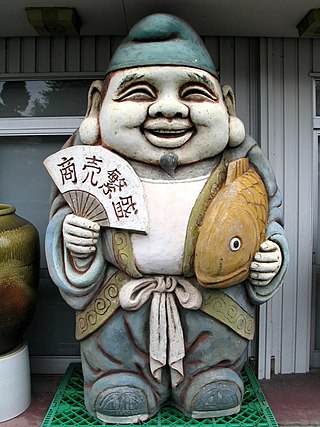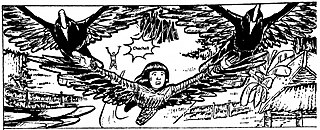
Shinto is frequently a theme in Japanese popular culture, including film, manga, anime, and video games. Shinto has influenced Japanese culture and history and as such greatly affects pop culture in modern Japan.

The Ashtabharya or Ashta-bharya(s) is the group of eight principal queen-consorts of Hindu god Krishna, the king of Dvaraka, Saurashtra in the Dvapara Yuga (epoch). The most popular list, found in the Bhagavata Purana, includes: Rukmini, Jambavati, Satyabhama, Kalindi, Nagnajiti, Mitravinda, Lakshmana and Bhadra. Variations exist in the Vishnu Purana and the Harivamsa, which includes queens called Madri or Rohini, instead of Bhadra. Most of them were princesses.

Numit Kappa is an ancient Meitei language mythological epic literary work. The work is believed to be written around or before 33 AD. It is written in the form of partial poetry and partial prose.

Yenakha Paotapi or Yenakha Paodabi Saijin Polibi, also known as the evil eavesdropper, is an old demoness. Stories often show her as an evil spirit. She lingers around the eaves of roofs in Meitei mythology and folklore of Ancient Kangleipak. She is described as the one who interferes everywhere. Legend says that she could not live with human beings. Instead, she lives like a dog or a jackal, sitting on graves. In some cases, she is depicted as a minor goddess in the Meitei religion.
Champavati is an Assamese folk tale. It was first collected in the compilation of Assamese folklore titled Burhi Aair Sadhu, by poet Lakshminath Bezbaroa. According to scholar Praphulladatta Goswami, the tale is "current in North Lakhimpur".
Yamata Amasung Keibu Keioiba is a Meitei language play, written and directed by Heisnam Tomba. It was produced by the Kalakshetra Manipur. This play weaves together the folktales of the two legendary creatures, Yamata-no-Orochi of Japan and Keibu Keioiba of Manipur.

Keibu Keioiba, also known as Kabui Keioiba, is a mythical creature with the head of a tiger and the body of a human in the Meitei mythology and folklore of Manipur. According to legend, he was once a skilful priest named Kabui Salang Maiba. He used witchcraft to turn himself into a ferocious tiger. As punishment of his pride, he could not completely turn back to his original human form.

Keibu Keioiba, also known as Kabui Keioiba, is a 2009 Manipuri animation feature film, directed by Bhumenjoy Konsam. It is the first Manipuri animation film, based on the Meitei folklore. It was screened in the 11th Mumbai International Film Festival (MIFF) in 2010, under the aegis of the Ministry of Information and Broadcasting.

The Meitei folktales, also sometimes referred to as the Manipuri folktales, are the large collections of folk stories developed from the Meitei culture since Ancient Kangleipak. Folktales are called "funga wari", literally meaning "stories of kitchen furnace or stove" in Meitei language. In early times, in the Meitei households, children must have gathered around the kitchen fire, listening to the stories narrated by the elders. Generally, Meitei folktales were developed from the creativity of the old folks, especially the grandparents, who narrated the children the diverse sagas of varying genres.

The legend of Sandrembi and Chaisra or Sanarembi and Chaisra is a folktale of the Meitei ethnicity of Ancient Kangleipak. It is a story of the clash between two stepsisters, Sandrembi (Sanarembi), the elder, and Chaisra, the younger, born to the same father but different mothers. Sandrembi, the protagonist, is a young lady, living in forsaken environment and in dire circumstances that are changed into a remarkable fortune. She is portrayed as a person having the nature of God like mind.

The story of Uchek Langmeitong or Chekla Langmeitong is a Meitei folktale of Ancient Kangleipak. It is the story of a girl named "Hayainu" who turned herself into a Langmeitong as she was unable to suffer the ill treatments of her cruel stepmother.

The Hanuba Hanubi Paan Thaaba, also known as the Hanubi Hentak! Hanuba Hentak!, is a Meitei folktale of Ancient Kangleipak. It is about the story of an old man, an old woman and some monkeys.

Animals have significant roles in different elements of Meitei culture, including but not limited to Meitei cuisine, Meitei dances, Meitei festivals, Meitei folklore, Meitei folktales, Meitei literature, Meitei mythology, Meitei religion, etc.

Kumcha Lempi, also known as Kumja Lembi, is a woman in Meitei mythology and folklore of ancient Kangleipak. She is known for being a victim of an attack by a tiger in Khoirentak. Her tragedy is frequently mentioned, narrated and retold in the Moirang Kangleirol legends, usually by the Pena playing balladeers till present times.

Japanese people and Meitei people have a long history of sharing and interacting with each other's art and cultural heritages, including but not limited to cinema, music, mythology, language, literature and theatre.
The Bacchae, also simply known as Bacchae, is a classical Meitei language play, based on an ancient Greek tragedy of the same name, written by Euripides, one of the three tragedians of classical Athens. Directed by Thawai Thiyam, son of Ratan Thiyam, it is based on the story of king Pentheus of Thebes and Olympian god Dionysus.
Hojang Taret is a classical Meitei language play based on Euripides's ancient Greek tragedy The Phoenician Women. It is directed by Oasis Sougaijam and produced by The Umbilical Theatre in Imphal, Kangleipak . It depicts the moral ambiguities of conflict between brothers resulting to the ruination of the ancient city of Thebes.

Pebet is a bird species mentioned in Meitei mythology and folklore of Kangleipak . It was believed to be a small sized bird, smaller than a sparrow. It was believed to be almost extinct.

Houdong, sometimes spelled as Haudong, appears frequently in Meitei mythology and Meitei folktales of the Meitei folklore of Ancient Kangleipak.

Khambrangchak is a bird species frequently mentioned in Meitei mythology, folklore of Ancient Kangleipak.

















